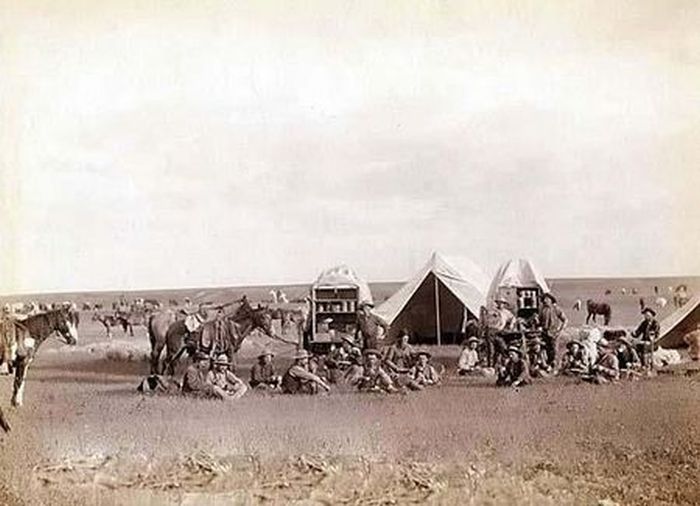|
|
History: American Old West, United States
|
A new code of behavior was becoming acceptable in the West. People no longer had a duty to retreat when threatened. This was a departure from British common law that required citizens to have their back to the wall before they could protect themselves with deadly force. In 1876 an Ohio court held if attacked a citizen was not "obligated to fly". The Indiana Supreme Court upheld the legality of "no duty to retreat". The code of the West dictated that a man did not have to back away from a fight, needing to retreat no further than "the air at his back", and could pursue an adversary even if it resulted in death.
In reality, the main activity of law enforcement in cattle towns was knocking down drunks and hauling them away before they hurt themselves or others. They also disarmed cowboys who violated gun control edicts, tried to prevent dueling, and dealt with flagrant breaches of gambling and prostitution ordinances. When the cattle were not in town, Wyatt Earp and other lawmen might be heading up street repair projects or doing other civic chores, or tending to their own business interests.
Most justices of the peace were poorly schooled in law, politically corrupt, and depended on assessing fees and fines to make a living. The better ones ruled by common sense and experience, but could be inconsistent as they did not refer to statutes to guide their rulings. Federal judges tended to have better qualifications and were more inclined to follow written law. However, the West also inherited the Anglo-American system of jury trials for serious cases in spite of the fact that most potential jurors were biased by their personal relationships and acquaintances and/or struggling to make ends meet, a combination which made honest and impartial jurors difficult to find in the best of circumstances.
Some of the banditry of the West was carried out by Mexicans and Indians against white targets of opportunity along the U.S. –Mexico border, particularly in Texas, Arizona, and California. Pancho Villa, after leaving his father's employ, took up the life of banditry in Durango and later in the state of Chihuahua. He was caught several times for crimes ranging from banditry to horse thievery and cattle rustling but, through influential connections, was always able to secure his release. Villa later became a controversial revolutionary folk hero, leading a band of Mexican raiders in attacks against various regimes and was sought after by the U.S. government. The second major type of banditry was conducted by the infamous outlaws of the West, including Jesse James, Billy the Kid, the Dalton Gang, Black Bart, Butch Cassidy and the Wild Bunch and hundreds of others who preyed on banks, trains, and stagecoaches. Some of the outlaws, such as Jesse James, were products of the violence of the Civil War (James had ridden with Quantrill's Raiders) and others became outlaws during hard times in the cattle industry. Many were misfits and drifters who roamed the West avoiding the law. When outlaw gangs were near, towns would raise a posse (like in the movies) to attempt to drive them away or capture them. Seeing that the need to combat the gunslingers was a growing business opportunity, Allan Pinkerton ordered his detective agency to open branches out West, and they got into the business of pursuing and capturing outlaws, like the James Gang, Butch Cassidy, Sam Bass, and dozens of others. Pinkerton devised the "rogues gallery" and employed a systematic method for identifying bodies of criminals.
|
|









